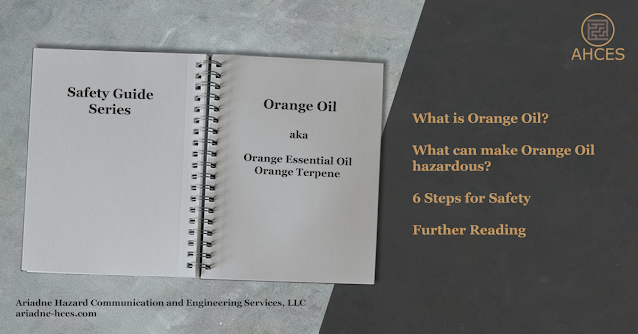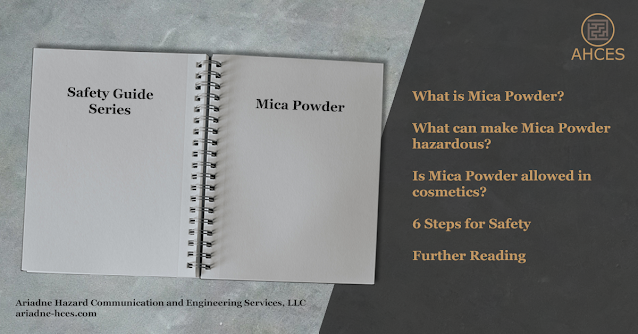Safety Guide Series Hub
An alphabetical listing of all of our guides in the Safety Guide Series.
- Acetone
- Used as a solvent, including as a glass cleaner in laboratories and as a nail polish remover.
- Primary Hazards: Flammable and Irritant, vapors can act as fuel in a fire and cause irritation to mucus membranes.
- BCDMH
- Used in pool cleaning as the primary ingredient in bromine tablets.
- Primary Hazards: Oxidizer, Corrosive, Irritant, and Environmental Hazard, can make fires worse, cause chemical burns, and is harmful to wildlife.
- Benzaldehyde
- Used as an almond fragrance and flavoring
- Primary Hazards: Irritant, can irritate skin, eyes, and respiratory system, and repeated exposure can sensitize skin.
- Chloroxylenol
- Used as an antiseptic and disinfectant for topical use.
- Primary Hazards: Irritant, can irritate skin, eyes, and respiratory system, and repeated exposure can sensitize skin.
- Chrome Green
- Used as a pigment, abrasive, and in metallurgy.
- Primary Hazards: Irritant and repeated contact can cause chromium sensitivity.
- Cinnamaldehyde
- Used as a cinnamon fragrance and flavoring, the primary component of cinnamon essential oil
- Primary Hazards: Irritant, can irritate skin, eyes, and respiratory system, and repeated exposure can sensitize skin.
- Citric Acid
- Used in many applications, including as a cleaning agent and flavoring agent
- Primary Hazard: Irritant, can irritate eyes and respiratory system
- Citronellol
- Used as a fragrance, the primary component in citronella essential oil, and used as a pesticide and insect deterrent
- Primary Hazards: Irritant, can irritate skin and eyes, and is also a known human allergen
- Clove Oil
- Used as a clove fragrance.
- Primary Hazards: irritant, can irritate skin, eyes, and respiratory system.
- Cupric Sulfate
- Used as an anti-algae and anti-fungal treatment in aquariums, copper additive in fertilizers, and mordant.
- Primary Hazards: Irritant and Environmental Hazard, can cause irritation to the skin, eyes, and mucus membranes and is harmful to aquatic environments.
- Ferric Chloride
- Used in water purification and sewage treatment, as well as in metal etching.
- Primary Hazards: Corrosive and Irritant, can cause chemical burns and irritation to the eyes, skin, and respiratory system.
- Formaldehyde
- Used as a fumigant, disinfectant, and fungicide, as well as an ingredient in some preservatives and resins.
- Primary Hazards: Irritant, Toxic, Carcinogenic, can cause irritation and damage to the skin and eyes and severe harm if ingested.
- Geraniol
- Used primarily as a fragrance, as well as a flavoring agent.
- Primary Hazards: Irritant, can cause skin and eye irritation as well as causing allergic reaction.
- Hydrochloric Acid
- Used in many applications, including leather tanning, electroplating, and heavy-duty cleaning.
- Primary Hazards: Corrosive, can cause chemical burns and irritation to the eyes, skin, and respiratory system.
- Lauramine Oxide
- Used as a surfactant in many products including hand soaps and household cleaners.
- Primary Hazards: Irritant and Environmental Hazard, can cause eye and respiratory irritation and can be harmful to the aquatic environment.
- Lauric Acid
- Used as an ingredient in soap making, found in coconut oil and palm kernel oil.
- Primary Hazards: Corrosive and Irritant, can cause chemical burns and irritation to the eyes and skin.
- Lye
- Used as a cleaning agent, in making soap, and making foods such as bagels and ramen noodles.
- Primary Hazard: Corrosive, can cause chemical burns.
- Manganese Black
- Used as a pigment and in dry-cell batteries.
- Primary Hazard: Irritant, and repeated exposure can cause manganism.
- Menthol
- Used as a mint flavoring and fragrance, as well as a topical painkiller.
- Primary Hazard: Irritant, can cause skin irritation and severe eye irritation.
- Methylene Blue
- Used as a disinfectant and anti-fungal in aquariums, a fabric dye, an organic stain in laboratories, and in some medical treatments.
- Primary Hazard: Corrosive and Irritant, can cause chemical burns and irritation to the eyes, skin, and mucus membranes.
- Mica Powder
- Used in cosmetics and art pigments for shimmery quality.
- Primary Hazard: Irritant, can cause respiratory damage and eye irritation.
- Myristamine Oxide
- Used as an antibacterial and foaming agent in shampoos and detergents.
- Primary Hazards: Corrosive and Irritant, can cause chemical burns and irritation to the skin, eyes, and mucus membranes.
- Octinoxate
- Used primarily as a UV-B blocker in chemical sunscreens
- Primary Hazards: Environmental Hazard and Sensitizer, has been linked to coral bleaching in aquatic environments and skin sensitization in some individuals
- Orange Oil
- Used as a cleaning agent and fragrance.
- Primary Hazards: Flammable, Irritant, and Toxic, can cause poisoning in people and animals.
- Oxalic Acid
- Used as a cleaning agent, bleaching agent, and mordant.
- Primary Hazard: Irritant, can cause irritation to the eyes, skin, and respiratory system.
- Phenolphthalein
- Used as a pH indicator for strong bases.
- Primary Hazards: Possible human carcinogen, possible reproductive toxin.
- Quaternium-15
- Used as a surfactant and preservative.
- Primary Hazards: Irritant, can cause skin irritation. Also suspected to be a human reproductive toxicant.
- Sandenol
- Used as a synthetic sandalwood fragrance.
- Primary Hazards: Irritant and Environmental Hazard, can cause eye and respiratory irritation and can be harmful to the aquatic environment.
- Sodium Carbonate
- Used as a detergent and cleaning agent, in textile processing, and in human and veterinary medicine.
- Primary Hazard: Irritant, can cause skin and eye irritation.
- Sodium Lauryl Sulfoacetate
- Used as a surfactant in cleaning products, including hand soaps and other personal cleaning products.
- Primary Hazard: Irritant, can cause skin, eye, and respiratory irritation.
- Sodium Silicate
- Used as an adhesive and in fireproofing coatings.
- Primary Hazards: Corrosive and Irritant, can cause chemical burns and irritation to the eyes, skin, and mucus membranes.
- Salicylic Acid
- Used as an antibacterial, antifungal, and topical painkiller.
- Primary Hazards: Corrosive and Irritant, can cause chemical burns and irritation to the eyes, skin, and respiratory system.
- Tannic Acid
- Used as a mordant, bleach resistance treatment, and wood treatment.
- Primary Hazard: Irritant, can cause irritation to the eyes, skin, and respiratory system.
- TCCA
- Used in pool cleaning as the primary ingredient in chlorine tablets and in cleaning as the primary ingredient in dry bleach products.
- Primary Hazards: Oxidizer, Irritant, and Environmental Hazard, can make fires worse, cause minor chemical burns, and is harmful to wildlife.
- Titanium Dioxide
- Used as a pigment in a wide range of products from art pigments to food.
- Primary Hazard: Irritant, can cause respiratory damage.
- Ultramarine Blue
- Used as an artist pigment.
- Primary Hazard: Reactive with Acid, produces toxic gases when exposed to acids.
- Vanillin
- Used as a vanilla fragrance and flavoring.
- Primary Hazard: Irritant, can be irritating to the eyes and respiratory system, can trigger an allergic skin reaction in individuals with a vanilla allergy.
- Zinc Chromate
- Used as a pigment and corrosion resistance coating.
- Primary Hazard: Irritant and Carcinogenic, can be irritating to the skin and respiratory system and contains hexavalent chrome, a known carcinogen linked to respiratory cancer.




